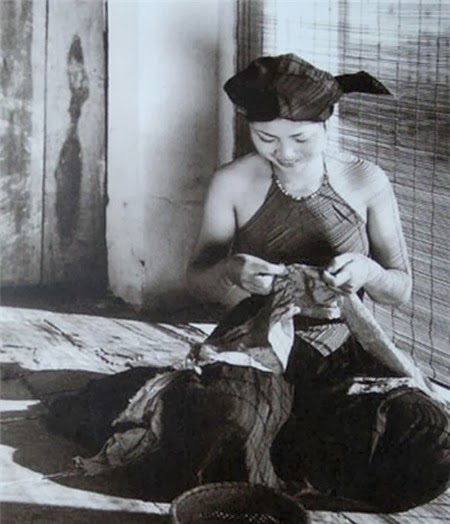 In the past for convenience at work, Hanoi women wore a brown, round-necked, mostly unbuttoned tunic outside a brown plastron. The plastron is a square piece of fabric or silk put diagonally across the chest, one corner is cut into a round or V-shaped neck. The plastron is tied to the body by two straps at the neck and two at the waist.
In the past for convenience at work, Hanoi women wore a brown, round-necked, mostly unbuttoned tunic outside a brown plastron. The plastron is a square piece of fabric or silk put diagonally across the chest, one corner is cut into a round or V-shaped neck. The plastron is tied to the body by two straps at the neck and two at the waist.For the bottom part, they wore a below-the-knee skirt, an held it by a floss silk belt wound around the hip once or many times, usually in a brown or olive color. In winter, they simply put on additional tunics; old people wore short black cotton-padded coats.
For going out, they put on an outer robe with four flaps, which is open without buttons, and the two front flaps are usually bound together. Alternatively, they could choose a five-flap dress with 3 front flaps, one shorter than the others. The latter had buttons from the neck down to the hip. Their long turbaned hair was around the head. The turban is a 3.5x1 foot fabric strip, in black or brown. To make a round, thick hair roll, they padded it with a 1.5 foot long ctton-stuffed roll; a string at the end of the roll was as long as the roll itself and helped to keep the hair in place. The first step to roll the hair was to part their hair in the middle, then put it all to one side, usually the left, put the pad roll inside as the core, then wind the string around the hair before wrapping the hair with the turban. After fixing the turban with a pin at the end, the woman would comb the hair roll length-wise to make sure it is neat. The she would put the hair roll around the head and slilde the end under the roll. If the hair is longer than the turban, the last tuft of the hair will be curved like a cock’s tail above the left ear. Such curved hair tuft was the most popular hair style, hence the old saying “Ten reasons to love a girl”:
“First is love for the protruding tuft of hair
Second is love for graceful talking"
Most women wore round silver ear-rings delicately carved by the silversmiths, rich ones wore gold ear-rings.
To cope up with the coldness in winter, women covered their heads with a black shawl, a square piece of fabric; each side is seventy to eighty centimeters long. A shawl should be folded diagonally, cover the ears and fastened under the chin.

Festival clothing was the same style as daily clothing, but more colorful. A three-layer dress included a four-flap robe made of brown, black or deep purple chiffon, the second and the third layers were yellowish, lotus-pink, or green. The dresses were round-necked with straight flaps. Only buttons at the side were fastened, while the ones from the neck to the armpit are left open to reveal the three dress layers in three colors. Inside the dress, women wore a V-necked tunic, and a rad plastron. Some used to put on an olive or peach silk belt as a highlight.
Using matching colors, long-straight robes, the ladies made the outfit so eye-catching but still decent. One important part of such festival outfits was the seven-length fine silk or floss-silk skirt. The lower hem balloons out like a wave; the upper hem was wide, always in bright colors such as green, pink, lime or yellow. The skirt's black body was the background for the colorful silk belts. The ladies would not forget to hang on their belts a silver key chain that held a silver lime container (for eating betel leaves and areca nuts), a small horn-handled sliver knife to cut areca nut which are also considered jewelry, and a peach-shaped box containing tobacco or betel-nuts.
For footwear, ordinary women walked barefoot in daily life. Only during long distance trips, did they wear flip-flops made from buffalo skin with cow-skin straps, similar to Thailand's flip-flops today.
For urban wealthy women, the traditional outfit was the same, just more sophisticated in color, better sewn from more expensive fabric. For example, the plastron's necks were rounded and sewn much better; the stitches looked like they were sewn by a sewing machine. On Hàng Đào street in Hanoi, house no.38, there was even a tailor specializing in sewing ready-to-wear plastron neck. For the tunic, they used 100% white silk. The turbans were mostly made from black velvet. All outer robes had five flaps, made of chiffon, gauze, etc. In winter, the favorite materials were smooth or printed brocade, or thick cotton, lined with blue or grey silk. Later on, urban ladies stopped wearing skirts and wore black satin trousers, with pink or olive-green upper hems. On holidays, they used to put on gold necklaces, the length depending on how rich they were, and gold bracelets or xuyến. Xuyến, a kind of flat bracelet with two ends hooked together, so that the user might adjust it ti fit her arm. Xuyến can be smooth or carved. Urban rich ladies did not wear round ear-rings but long, delicate gold ear-rings. The put on high-heeled leather sandals or embroidered shoes.
However, in 20th century the fashion for Hanoi women has changed dramatically. With urbanization changing the face of Hanoi, the clothes, jewelry, accessories and fabrics have changed and a "New Fashion" style has emerged.
Hanoi Women's Clothes At The End Of The 19th Century.



0 comments:
Post a Comment